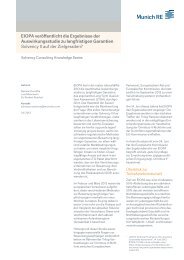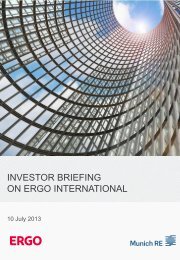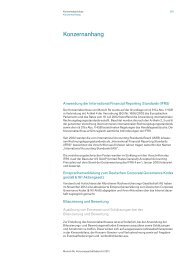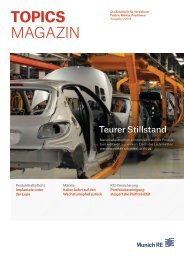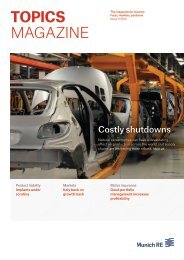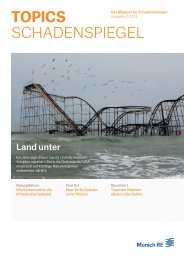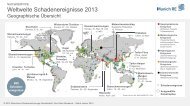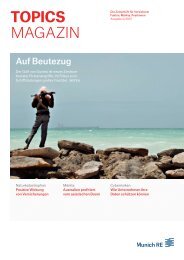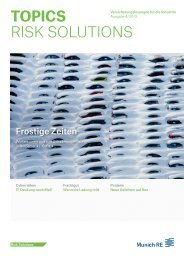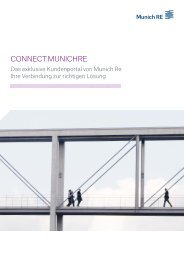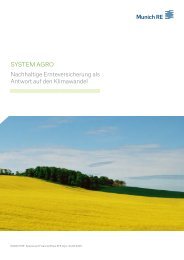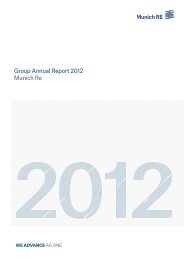Munich Re Group Annual Report 2006 (PDF, 1.8
Munich Re Group Annual Report 2006 (PDF, 1.8
Munich Re Group Annual Report 2006 (PDF, 1.8
You also want an ePaper? Increase the reach of your titles
YUMPU automatically turns print PDFs into web optimized ePapers that Google loves.
<strong>Munich</strong> <strong>Re</strong> <strong>Group</strong> <strong>Annual</strong> <strong>Re</strong>port <strong>2006</strong> Management report_Primary insurance<br />
In health, premium income grew by 4.3% to €5.1bn (4.9bn) –<br />
the strongest growth of all. This increase was due to the<br />
further expansion of new supplementary health insurance<br />
business in Germany, where we recorded a rise of 15.6% to<br />
over four million clients, and to the very satisfactory growth<br />
rate of 15.1% in other countries, above all Belgium and<br />
Spain. In German comprehensive health insurance, the<br />
political debate about health reform continued to cause<br />
uncertainty among clients, curbing the growth that would<br />
normally be present in this segment.<br />
The investment result in life and health totalled €4.1bn<br />
(5.1bn), a decline of 18.5% due not only to the conversion<br />
of HVB shares and the sale of Karlsruher in the previous<br />
year, but also to interest-rate trends. The rise in interest<br />
rates in the first six months, which was partially reversed<br />
between July and December, triggered a loss of about<br />
€283m in the value of our long-term hedges against changing<br />
interest rates. We account for these hedges at fair value<br />
and recognised the fall in value as an impairment loss.<br />
The purpose of these derivative financial instruments is to<br />
cover the interest rates guaranteed to our life insurance<br />
customers, enabling us to meet our commitments, even<br />
if interest rates remain very low for a long period of time,<br />
without having to forgo the opportunities presented by<br />
rising interest rates. The value of these derivatives fell by<br />
€330m to €105m towards the middle of the year as a result<br />
Gross premiums in the property-casualty segment in €bn<br />
<strong>2006</strong><br />
2005<br />
2004<br />
2003<br />
2002<br />
of rising interest rates, but rose again to €153m in the second<br />
half of the year. In the previous year, the investment<br />
result had been positively affected by particularly high<br />
gains from the disposal of shares in the financial sector.<br />
As expected, expenses for claims and benefits were<br />
also affected by the investment result, which is particularly<br />
significant in this respect in life and health business. These<br />
expenses were up as a result of payouts in life insurance<br />
and rising prices in healthcare, but this increase was offset<br />
by lower net allocations to the provisions for future policy<br />
benefits and the provision for premium refunds. Expenses<br />
therefore experienced an overall decrease of 7.0%.<br />
Costs also developed very favourably. Despite high<br />
expenses for new IT systems in health, the administrative<br />
expense ratio remained constant at a favourable 3.4%. In<br />
life, the administrative expense ratio was reduced from<br />
4.5% to 4.4%, reflecting our firm cost discipline, which we<br />
intend to maintain.<br />
Property-casualty<br />
In property-casualty we again achieved a very good consolidated<br />
result of €726m (585m).<br />
Premium income totalled €5.1bn (5.3bn). Adjusted for<br />
the changes in the consolidated group, premium grew by<br />
2.8% to €5.1bn (4.9bn).<br />
5.1<br />
5.3<br />
5.2<br />
5.1<br />
4.8<br />
89



